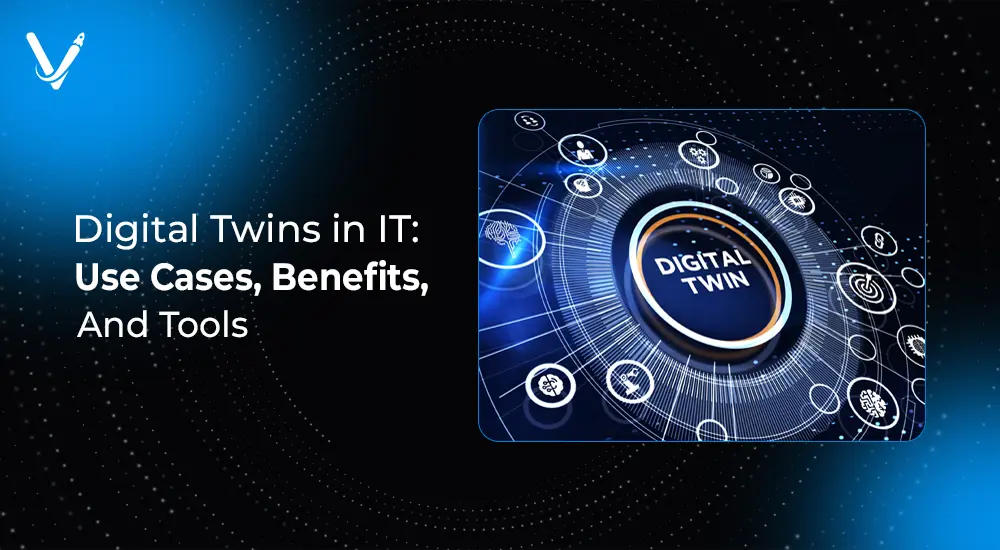Digital Twins in IT: Use Cases, Benefits, and Tools


- Jul 13, 2025
Imagine having a virtual mirror of your IT infrastructure, networks, or entire manufacturing line, allowing you to experiment, monitor, and optimize operations safely and intelligently. This is not science fiction. It is the promise of Digital Twin Solutions.
What is Digital Twin Technology? It is the creation of a dynamic, virtual replica of a physical system, updated in real-time using data and advanced simulation technologies. This technology allows IT teams, manufacturers, and network architects to test scenarios, predict failures, and optimize systems while reducing costs and downtime.
Today, we explore Digital Twin Use Cases, actionable benefits, industry-leading tools, real-world examples, and how your organization can strategically adopt digital twin technologies to stay competitive.
Digital Twin Technology refers to creating a virtual model of a physical object, system, or process that accurately mimics its behavior using real-time data. Sensors on the physical system send live updates to its digital twin, allowing analysis, simulation, and prediction.
Unlike static 3D models, digital twins evolve alongside their physical counterparts, leveraging machine learning, IoT, and AI to predict issues, recommend maintenance, and streamlineq workflows.
Key characteristics:
In the IT landscape, digital twin solutions transform traditional operations into predictive, intelligent systems:
Digital twin technology enables IT teams to shift from reactive management to proactive optimization, increasing operational reliability and efficiency.
A network digital twin creates a virtual replica of an organization’s network infrastructure, enabling engineers to test changes, identify vulnerabilities, and optimize traffic flows before implementing them in the live environment.
Benefits:
Real-world example: Cisco uses network digital twin technologies to simulate traffic and optimize SD-WAN configurations, reducing downtime and improving network performance.
Digital twins in manufacturing represent entire production lines or individual machinery, enabling predictive maintenance and process optimization.
Key outcomes:
Case study: Siemens’ Amberg facility uses digital twin technology to simulate production lines, resulting in a 25% reduction in defects and a 30% increase in efficiency.
A digital twin of a customer journey, created using real-time data, can help businesses personalize services and improve customer satisfaction.
Applications:
For smart buildings, digital twin building solutions can simulate and monitor energy consumption, occupancy, HVAC systems, and maintenance needs.
Advantages:
A twin application can be used across the product lifecycle to simulate product behavior, analyze customer usage, and improve design iterations based on real-world feedback.
Benefits:
These companies using digital twins demonstrate how real-time simulation and optimization can drive operational excellence across sectors.
Implementing digital twin technology delivers measurable benefits:
To leverage digital twin technologies, understanding their core components is essential:
These components work together to create a live, actionable digital twin platform that enables data-driven transformation.
Selecting the right digital twin software is crucial for effective implementation. Here are leading tools:
Microsoft’s platform allows the creation of comprehensive models of physical environments, supporting rich analysis, simulation, and real-time monitoring.
Used for digital twins in manufacturing, Siemens NX integrates design, simulation, and manufacturing in a unified platform.
Enables engineers to create simulation-based digital twins for predictive maintenance and system optimization.
A popular digital twin software providing advanced IoT connectivity, visualization, and analytics for industrial environments.
Provides asset monitoring and predictive maintenance, leveraging digital twin technology to optimize performance and reduce costs.
While the benefits are substantial, there are challenges:
These challenges can be mitigated by engaging with digital twin consulting experts to plan phased implementation strategies.
Healthcare: Simulating patient physiology to personalize treatment.
Smart Cities: Using digital twin solutions to optimize traffic flow, waste management, and energy usage.
Energy Sector: Simulating grid performance, predicting outages, and managing renewable energy sources.
Retail: Optimizing supply chains, warehouse operations, and customer journey mapping.
Automotive: Testing vehicle performance in different conditions without physical prototypes.
The digital twin market is evolving rapidly, with trends like:
These advancements will continue to enhance the capabilities of digital twin solutions across industries.
Step 1: Define Objectives
Identify what you want to achieve (e.g., reduce downtime, improve efficiency).
Step 2: Identify Data Sources
List IoT sensors and existing systems to integrate data flows.
Step 3: Choose the Right Digital Twin Platform
Select software that aligns with your infrastructure and goals.
Step 4: Build the Digital Twin Model
Create a virtual replica with input from IT, engineering, and operations teams.
Step 5: Test and Optimize
Run simulations, analyze results, and refine models.
Step 6: Scale Gradually
Start with a pilot project, analyze ROI, and expand across other systems.
Step 7: Train Teams
Equip teams with the skills needed to manage and evolve digital twin systems.
Engaging digital twin consulting can help:
Partnering with experts accelerates deployment while avoiding common pitfalls.
Digital twin technology is no longer optional for organizations aiming to stay competitive in a rapidly evolving landscape. With its ability to simulate, analyze, and optimize physical systems virtually, digital twins empower IT teams to:
Whether it’s leveraging a network digital twin for better bandwidth management or deploying digital twins in manufacturing for predictive maintenance, the technology delivers tangible value.
Ready to transform your operations with digital twin solutions?
Vasundhara Infotech helps businesses implement scalable, secure, and ROI-focused digital twin strategies tailored to your industry and goals.
Contact us today to book your free consultation and explore how digital twins can future-proof your operations.
Copyright © 2025 Vasundhara Infotech. All Rights Reserved.
